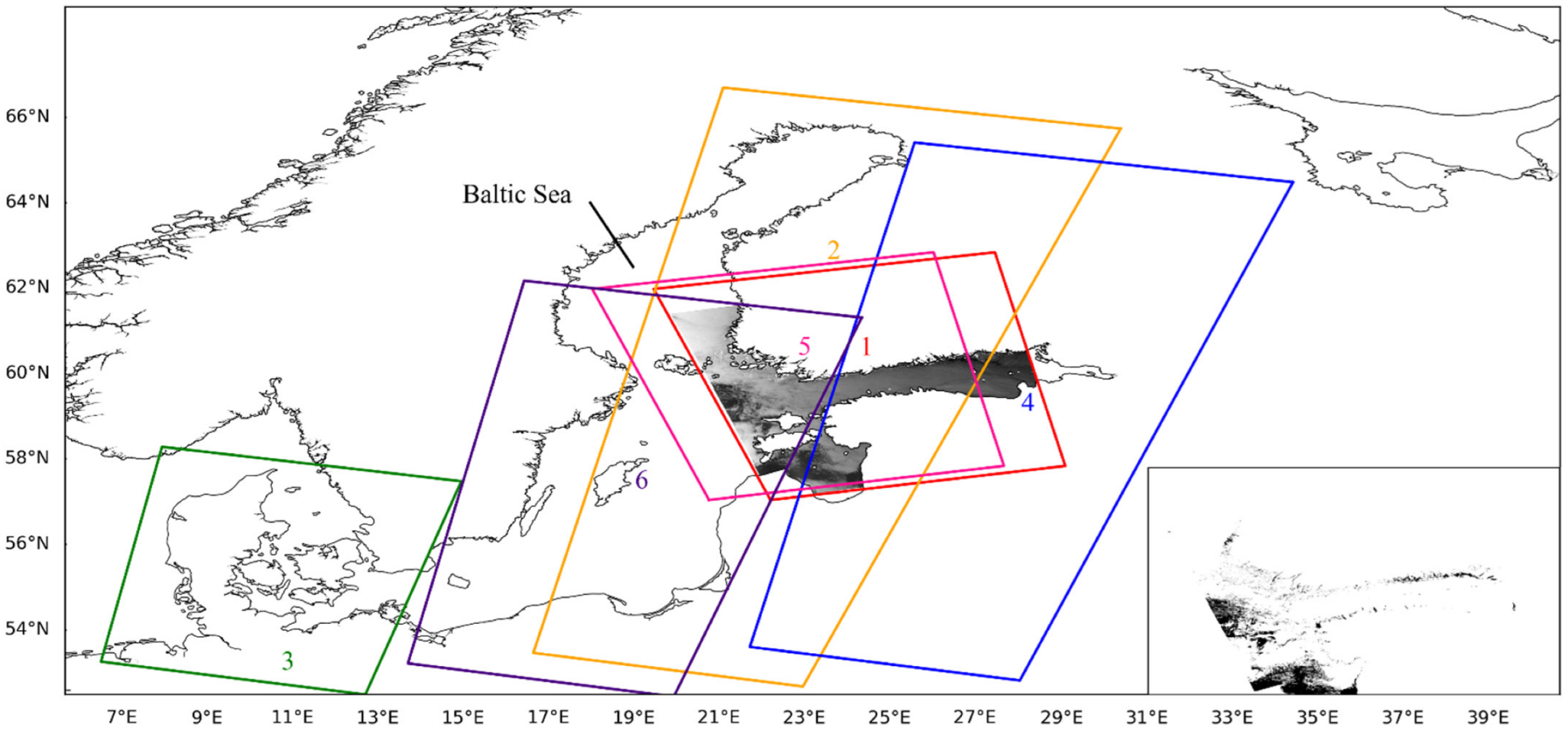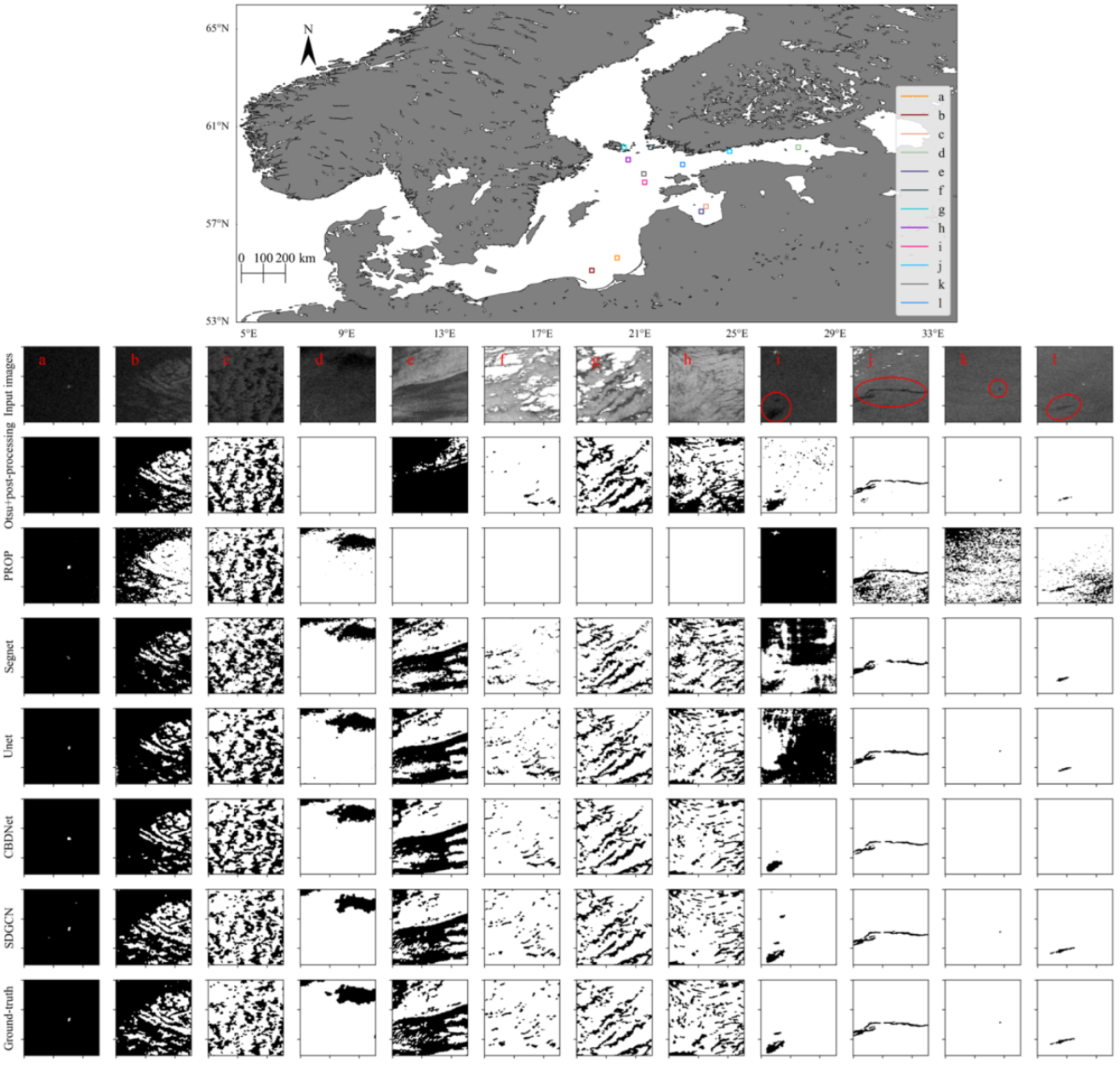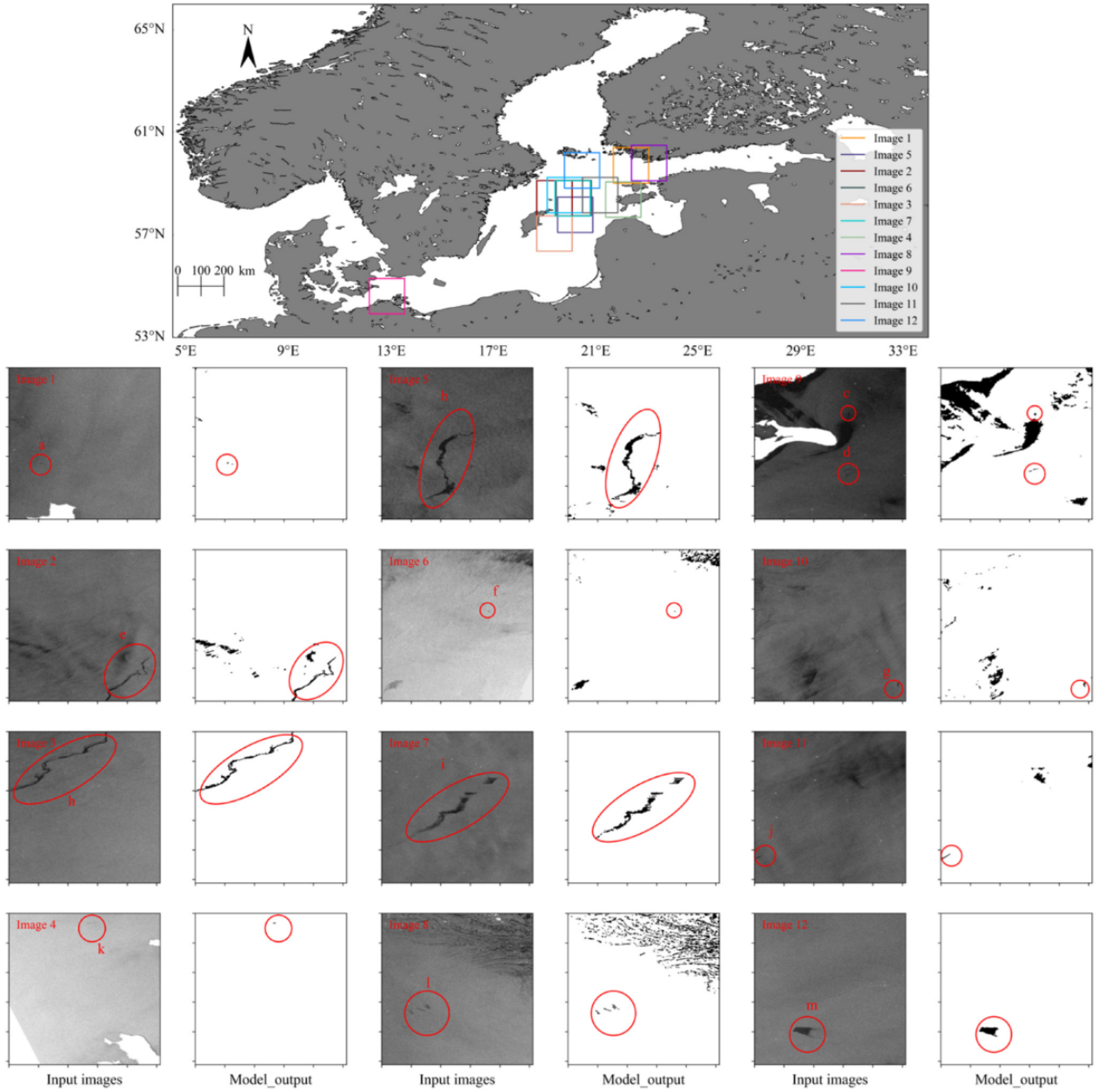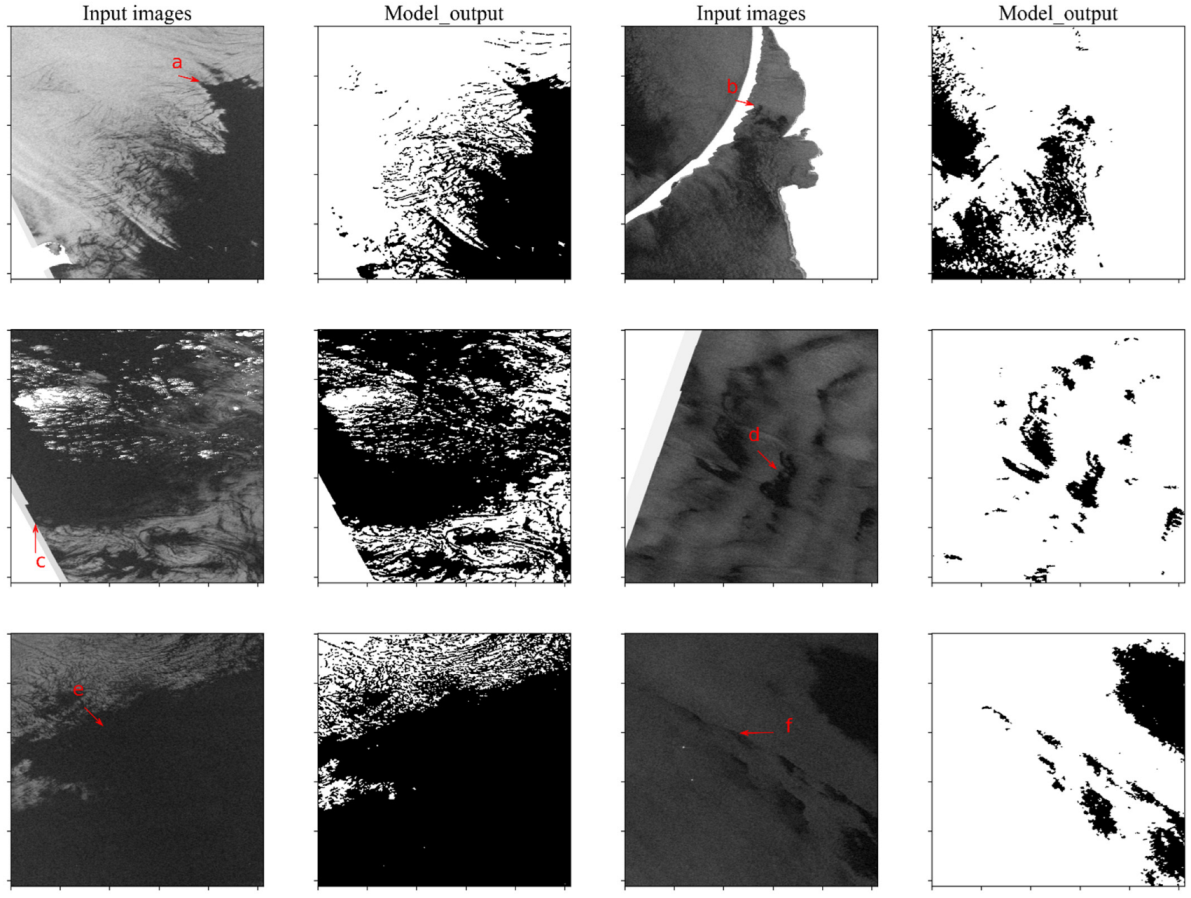Dark Spot Detection from SAR Images Based on Superpixel Deeper Graph Convolutional Network
Abstract
1. Introduction
2. Data and Study Region
3. Method
3.1. Conversion of the Image to Graph Structures
3.2. Feature Extraction and Feature Selection
3.3. Deep Learning on Graphs
4. Results
4.1. Implementation Details
4.2. Evaluation Metrics
4.3. Effect of Feature Selection
4.4. Comparison with Several Competitive Baselines
5. Discussion
6. Conclusions
Supplementary Materials
Author Contributions
Funding
Institutional Review Board Statement
Data Availability Statement
Acknowledgments
Conflicts of Interest
References
- Cheng, L.; Li, Y.; Zhang, X.; Xie, M. An Analysis of the Optimal Features for Sentinel-1 Oil Spill Datasets Based on an Improved J–M/K-Means Algorithm. Remote Sens. 2022, 14, 4290. [Google Scholar] [CrossRef]
- Rousso, R.; Katz, N.; Sharon, G.; Glizerin, Y.; Kosman, E.; Shuster, A. Automatic Recognition of Oil Spills Using Neural Networks and Classic Image Processing. Water 2022, 14, 1127. [Google Scholar] [CrossRef]
- Feng, J.; Chen, H.; Bi, F.; Li, J.; Wei, H. Detection of oil spills in a complex scene of SAR imagery. Sci. China Technol. Sci. 2014, 57, 2204–2209. [Google Scholar] [CrossRef]
- Solberg, A.H.S. Remote Sensing of Ocean Oil-Spill Pollution. Proc. IEEE 2012, 100, 2931–2945. [Google Scholar] [CrossRef]
- Chen, L.; Ni, J.; Luo, Y.; He, Q.; Lu, X. Sparse SAR Imaging Method for Ground Moving Target via GMTSI-Net. Remote Sens. 2022, 14, 4404. [Google Scholar] [CrossRef]
- Li, Y.; Li, J. Oil spill detection from SAR intensity imagery using a marked point process. Remote Sens. Environ. 2010, 114, 1590–1601. [Google Scholar] [CrossRef]
- Shu, Y.; Li, J.; Yousif, H.; Gomes, G. Dark-spot detection from SAR intensity imagery with spatial density thresholding for oil-spill monitoring. Remote Sens. Environ. 2010, 114, 2026–2035. [Google Scholar] [CrossRef]
- Topouzelis, K.N. Oil Spill Detection by SAR Images: Dark Formation Detection, Feature Extraction and Classification Algorithms. Sensors 2008, 8, 6642–6659. [Google Scholar] [CrossRef]
- Chehresa, S.; Amirkhani, A.; Rezairad, G.-A.; Mosavi, M.R. Optimum Features Selection for oil Spill Detection in SAR Image. J. Indian Soc. Remote Sens. 2016, 44, 775–787. [Google Scholar] [CrossRef]
- Solberg, A.H.S.; Brekke, C.; Husoy, P.O. Oil Spill Detection in Radarsat and Envisat SAR Images. IEEE Trans. Geosci. Remote Sens. 2007, 45, 746–755. [Google Scholar] [CrossRef]
- Topouzelis, K.; Karathanassi, V.; Pavlakis, P.; Rokos, D. Dark formation detection using recurrent neural networks and SAR data. In Proceedings of the Image and Signal Processing for Remote Sensing XII, Stockholm, Sweden, 11–14 September 2006; pp. 324–330. [Google Scholar] [CrossRef]
- Taravat, A.; Latini, D.; Del Frate, F. Fully Automatic Dark-Spot Detection From SAR Imagery With the Combination of Nonadaptive Weibull Multiplicative Model and Pulse-Coupled Neural Networks. IEEE Trans. Geosci. Remote Sens. 2014, 52, 2427–2435. [Google Scholar] [CrossRef]
- Lang, H.; Zhang, X.; Xi, Y.; Zhang, X.; Li, W. Dark-spot segmentation for oil spill detection based on multifeature fusion classification in single-pol synthetic aperture radar imagery. J. Appl. Remote Sens. 2017, 11, 15006. [Google Scholar] [CrossRef]
- Xu, L.; Shafiee, M.J.; Wong, A.; Clausi, D.A. Fully Connected Continuous Conditional Random Field With Stochastic Cliques for Dark-Spot Detection In SAR Imagery. IEEE J. Sel. Top. Appl. Earth Obs. Remote Sens. 2016, 9, 2882–2890. [Google Scholar] [CrossRef]
- Guo, H.; Wei, G.; An, J. Dark Spot Detection in SAR Images of Oil Spill Using Segnet. Appl. Sci. 2018, 8, 2670. [Google Scholar] [CrossRef]
- Cantorna, D.; Dafonte, C.; Iglesias, A.; Arcay, B. Oil spill segmentation in SAR images using convolutional neural networks. A comparative analysis with clustering and logistic regression algorithms. Appl. Soft Comput. 2019, 84, 105716. [Google Scholar] [CrossRef]
- Yekeen, S.T.; Balogun, A.L. Automated Marine Oil Spill Detection Using Deep Learning Instance Segmentation Model. Int. Arch. Photogramm. Remote Sens. Spat. Inf. Sci. 2020, 43, 1271–1276. [Google Scholar] [CrossRef]
- Dollár, K.H.G.G.P.; Girshick, R. Mask r-cnn. In Proceedings of the IEEE International Conference on Computer Vision, Venice, Italy, 22–29 October 2017; pp. 2961–2969. [Google Scholar]
- Simonyan, K.; Zisserman, A. Very deep convolutional networks for large-scale image recognition. arXiv 2014, arXiv:1409.1556. [Google Scholar]
- Zeng, K.; Wang, Y. A Deep Convolutional Neural Network for Oil Spill Detection from Spaceborne SAR Images. Remote Sens. 2020, 12, 1015. [Google Scholar] [CrossRef]
- Basit, A.; Siddique, M.A.; Bhatti, M.K.; Sarfraz, M.S. Comparison of CNNs and Vision Transformers-Based Hybrid Models Using Gradient Profile Loss for Classification of Oil Spills in SAR Images. Remote Sens. 2022, 14, 2085. [Google Scholar] [CrossRef]
- Zhu, Q.; Zhang, Y.; Li, Z.; Yan, X.; Guan, Q.; Zhong, Y.; Zhang, L.; Li, D. Oil Spill Contextual and Boundary-Supervised Detection Network Based on Marine SAR Images. IEEE Trans. Geosci. Remote Sens. 2022, 60, 5213910. [Google Scholar] [CrossRef]
- Uziel, R.; Ronen, M.; Freifeld, O. Bayesian Adaptive Superpixel Segmentation. In Proceedings of the 2019 IEEE/CVF International Conference on Computer Vision (ICCV), Seoul, Korea, 27 October–2 November 2019; pp. 8469–8478. [Google Scholar]
- Zhang, J.; Feng, H.; Luo, Q.; Li, Y.; Zhang, Y.; Li, J.; Zeng, Z. Oil Spill Detection with Dual-Polarimetric Sentinel-1 SAR Using Superpixel-Level Image Stretching and Deep Convolutional Neural Network. Remote Sens. 2022, 14, 3900. [Google Scholar] [CrossRef]
- Li, Y.; Chen, W.; Huang, X.; Gao, Z.; Li, S.; He, T.; Zhang, Y. MFVNet: Deep Adaptive Fusion Network with Multiple Field-of-Views for Remote Sensing Image Semantic Segmentation. Sci. China Inform. Sci. 2022. [Google Scholar] [CrossRef]
- Li, G.; Muller, M.; Thabet, A.; Ghanem, B. DeepGCNs: Can GCNs Go As Deep As CNNs? In Proceedings of the 2019 IEEE/CVF International Conference on Computer Vision (ICCV), Seoul, Korea, 27 October–2 November 2019; pp. 9266–9275. [Google Scholar]
- Liu, M.; Gao, H.; Ji, S. Towards Deeper Graph Neural Networks. In Proceedings of the 26th ACM SIGKDD International Conference on Knowledge Discovery & Data Mining, Virtual, 6–10 July 2020; pp. 338–348. [Google Scholar]
- European Space Agency. ASAR Product Handbook; ESA: Paris, France, 2007; pp. 94–97. [Google Scholar]
- Najoui, Z.; Riazanoff, S.; Deffontaines, B.; Xavier, J.-P. A Statistical Approach to Preprocess and Enhance C-Band SAR Images in Order to Detect Automatically Marine Oil Slicks. IEEE Trans. Geosci. Remote Sens. 2018, 56, 2554–2564. [Google Scholar] [CrossRef]
- Konik, M.; Bradtke, K. Object-oriented approach to oil spill detection using ENVISAT ASAR images. ISPRS J. Photogramm. Remote Sens. 2016, 118, 37–52. [Google Scholar] [CrossRef]
- Misra, A.; Balaji, R. Simple Approaches to Oil Spill Detection Using Sentinel Application Platform (SNAP)-Ocean Application Tools and Texture Analysis: A Comparative Study. J. Indian Soc. Remote Sens. 2017, 45, 1065–1075. [Google Scholar] [CrossRef]
- Genovez, P.; Ebecken, N.; Freitas, C.; Bentz, C.; Freitas, R. Intelligent hybrid system for dark spot detection using SAR data. Expert Syst. Appl. 2017, 81, 384–397. [Google Scholar] [CrossRef]
- Habart, D.; Borovec, J.; Švihlík, J.; Kybic, J. Supervised and unsupervised segmentation using superpixels, model estimation, and graph cut. J. Electron. Imaging 2017, 26, 061610. [Google Scholar] [CrossRef]
- Giraud, R.; Ta, V.-T.; Papadakis, N. Robust superpixels using color and contour features along linear path. Comput. Vis. Image Underst. 2018, 170, 1–13. [Google Scholar] [CrossRef]
- Solberg, S.; Brekke, C.; Husoy, O. Algorithms for Oil Spill Detection in Radarsat and ENVISAT SAR Images. In Proceedings of the IGARSS 2004, 2004 IEEE International Geoscience and Remote Sensing Symposium, Anchorage, AK, USA, 20–24 September 2007; pp. 4909–4912. [Google Scholar]
- Vyas, K.; Shah, P.; Patel, U.; Zaveri, T.; Kumar, R. Oil Spill Detection from SAR Image Data for Remote Monitoring of Marine Pollution Using Light Weight ImageJ Implementation. In Proceedings of the 2015 5th Nirma University International Conference on Engineering (NUiCONE), Ahmedabad, India, 26–28 November 2015; pp. 1–6. [Google Scholar] [CrossRef]
- Mera, D.; Bolon-Canedo, V.; Cotos, J.; Alonso-Betanzos, A. On the use of feature selection to improve the detection of sea oil spills in SAR images. Comput. Geosci. 2017, 100, 166–178. [Google Scholar] [CrossRef]
- Rong, Y.; Huang, W.; Xu, T.; Huang, J. DropEdge: Towards Deep Graph Convolutional Networks on Node Classification. In Proceedings of the International Conference on Learning Representations (ICLR), Virtual, 26 April–1 May 2020. [Google Scholar]
- Kipf, T.N.; Welling, M. Semi-supervised classification with graph convolutional networks. In Proceedings of the International Conference on Learning Representations (ICLR), Toulon, France, 24–26 April 2017. [Google Scholar]
- Li, G.; Xiong, C.; Thabet, A.; Ghanem, B. Deepergcn: All you need to train deeper gcns. arXiv 2020, arXiv:2006.07739. [Google Scholar]
- Zhang, M.; Chen, Y. Link prediction based on graph neural networks. In Advances in Neural Information Processing Systems; Curran Associates Inc.: Montréal, QC, Canada, 2018; pp. 5171–5181. [Google Scholar]
- Lee, J.; Lee, I.; Kang, J.J.A. Self-Attention Graph Pooling. In Proceedings of the 36th International Conference on Machine Learning, Long Beach, CA, USA, 9–15 June 2019. [Google Scholar]
- Javan, F.D.; Samadzadegan, F.; Gholamshahi, M.; Mahini, F.A. A Modified YOLOv4 Deep Learning Network for Vision-Based UAV Recognition. Drones 2022, 6, 160. [Google Scholar] [CrossRef]
- Ronneberger, O.; Fischer, P.; Brox, T. U-Net: Convolutional Networks for Biomedical Image Segmentation. In Proceedings of the 18th International Conference, Medical Image Computing and Computer-Assisted Intervention, MICCAI 2015, Munich, Germany, 5–9 October 2015; pp. 234–241. [Google Scholar]
- Garcia-Pineda, O.; Zimmer, B.; Howard, M.; Pichel, W.G.; Li, X.; MacDonald, I.R. Using SAR images to delineate ocean oil slicks with a texture-classifying neural network algorithm (TCNNA). Can. J. Remote Sens. 2009, 35, 411–421. [Google Scholar] [CrossRef]
- Berry, A.; Dabrowski, T.; Lyons, K. The oil spill model OILTRANS and its application to the Celtic Sea. Mar. Pollut. Bull. 2012, 64, 2489–2501. [Google Scholar] [CrossRef] [PubMed]
- Alpers, W.; Holt, B.; Zeng, K. Oil spill detection by imaging radars: Challenges and pitfalls. Remote Sens. Environ. 2017, 201, 133–147. [Google Scholar] [CrossRef]
- Hao, X.; Ji, Z.; Li, X.; Yin, L.; Liu, L.; Sun, M.; Liu, Q.; Yang, R. Construction and Application of a Knowledge Graph. Remote Sens. 2021, 13, 2511. [Google Scholar] [CrossRef]
- Li, Y.; Kong, D.; Zhang, Y.; Tan, Y.; Chen, L. Robust deep alignment network with remote sensing knowledge graph for zero-shot and generalized zero-shot remote sensing image scene classification. ISPRS J. Photogramm. Remote Sens. 2021, 179, 145–158. [Google Scholar] [CrossRef]
- Pu, W.; Wang, Z.; Liu, D.; Zhang, Q. Optical Remote Sensing Image Cloud Detection with Self-Attention and Spatial Pyramid Pooling Fusion. Remote Sens. 2022, 14, 4312. [Google Scholar] [CrossRef]
- Liu, B.; Hu, J.; Bi, X.; Li, W.; Gao, X. PGNet: Positioning Guidance Network for Semantic Segmentation of Very-High-Resolution Remote Sensing Images. Remote Sens. 2022, 14, 4219. [Google Scholar] [CrossRef]








| No | Feature | Code | Category | No | Feature | Code | Category |
|---|---|---|---|---|---|---|---|
| 1 | Area | A | Geometrical | 25 | Var_area_superpixel | Vas | Textura |
| 2 | Perimeter | P | Geometrical | 26 | Mean Haralick | H | Textura |
| 3 | Perimeter to area ratio | P/A | Geometrical | 27 | Object mean | Om | Physical |
| 4 | Area to perimeter ratio | A/P | Geometrical | 28 | Object standard deviation | Osd | Physical |
| 5 | Elongation | E | Geometrical | 29 | Background mean | Bm | Physical |
| 6 | Major axis to perimeter ratio | Maxx/P | Geometrical | 30 | Background standard deviation | Bsd | Physical |
| 7 | Complexity1 | Cp1 | Geometrical | 31 | Mean of the contrast ratio | Crm | Physical |
| 8 | Complexity2 | Cp2 | Geometrical | 32 | Standard deviation of the contrast ratio | Crsd | Physical |
| 9 | Circularity | C | Geometrical | 33 | Object power to mean | Opm | Physical |
| 10 | Spreading | S | Geometrical | 34 | Background power to mean | Bpm | Physical |
| 11 | Superpixel width | Sw | Geometrical | 35 | Ratio of the power to mean ratios | Opm/Bpm | Physical |
| 12 | Curvature | Cu | Geometrical | 36 | Max contrast | Cmax | Physical |
| 13 | Hu moments | Hu | Geometrical | 37 | Mean contrast | Cm | Physical |
| 14 | Fluser and Suk moments | Fs | Geometrical | 38 | RISDI | RISDI | Physical |
| 15 | Thickness | T | Geometrical | 39 | RISDO | RISDO | Physical |
| 16 | Shape connectivity | Shc | Geometrical | 40 | IOR | IOR | Physical |
| 17 | Form factor | Ff | Geometrical | 41 | Gradient mean | Gm | Physical |
| 18 | Length to width ratio | L/W | Geometrical | 42 | Gradient standard deviation | Gsd | Physical |
| 19 | Shape index | Si | Geometrical | 43 | Max. gradient | Gmax | Physical |
| 20 | Narrowness | N | Geometrical | 44 | Object border gradient | Obg | Physical |
| 21 | Rectangular saturation | Rs | Geometrical | 45 | Surrounding Power-to-mean ratio | Spm | Physical |
| 22 | Marking ratio | Mr | Geometrical | 46 | RIIA | RIIA | Physical |
| 23 | Solidity | Sd | Geometrical | 47 | Elliptic Fourier Descriptors | EFD | Geometrical |
| 24 | Mean of the interior angles based on bounding polygons | IABPm | Geometrical | 48 | Standard deviation of the interior angles based on bounding polygons | IABPsd | Geometrical |
| Rank | Code | Category | Rank | Code | Category | Rank | Code | Category |
|---|---|---|---|---|---|---|---|---|
| 1 | RIIA | Physical | 11 | Fs4 | Geometrical | 21 | Bsd | Physical |
| 2 | Cm | Physical | 12 | Cp1 | Geometrical | 22 | IOR | Physical |
| 3 | Obg | Physical | 13 | Vas | Textural | 23 | Bpm | Physical |
| 4 | Gm | Physical | 14 | A/P | Geometrical | 24 | Bm | Physical |
| 5 | RISDO | Physical | 15 | Fs3 | Geometrical | 25 | Cp2 | Geometrical |
| 6 | A | Geometrical | 16 | RISDI | Physical | 26 | L/W | Geometrical |
| 7 | P | Geometrical | 17 | Spm | Physical | 27 | E | Geometrical |
| 8 | C | Geometrical | 18 | Rs | Geometrical | 28 | Si | Geometrical |
| 9 | Om | Physical | 19 | Sd | Geometrical | 29 | P/A | Geometrical |
| 10 | Osd | Physical | 20 | Mr | Geometrical | 30 | T | Geometrical |
| Model | Pd (100%) | Pf (100%) | F1 Sore (100%) | Pm (100%) |
|---|---|---|---|---|
| SDGCN with the top 30 feature values | 96.98 | 5.68 | 95.63 | 7.18 |
| SDGCN with all feature values | 95.74 | 6.68 | 94.52 | 8.73 |
| Method | Pd (100%) | Pf (100%) | F1 Score (100%) | Pm (100%) |
|---|---|---|---|---|
| Otsu+post-processing [9] | 71.74 | 12.78 | 78.73 | 26.35 |
| PROP [13] | 90.36 | 52.71 | 62.09 | 10.36 |
| SegNet [15] | 83.00 | 8.88 | 87.02 | 13.03 |
| UNet [37] | 83.20 | 6.69 | 87.96 | 9.68 |
| CBD-Net [17] | 91.99 | 10.70 | 90.62 | 25.30 |
| Our SDGCN | 96.98 | 5.68 | 95.63 | 7.18 |
| Dark Spot | Mean Wind (m/s) | Mean Sea Water Velocity (m/s) | Mean Convective Rain Rate (kg·m−2·s−1) | The Temperature Difference between the Atmosphere and the Ocean (K) | Mean Chlorophyll-a Concentration (mg/m3) |
|---|---|---|---|---|---|
| a | 0.195 | 0.088 | 0 | 0.635 | 2.128 |
| b | 4.009 | 0.040 | 0 | −0.704 | 17.400 |
| c | 0.289 | 0.058 | 0 | 0.201 | 2.459 |
| d | 4.750 | 0.083 | 0 | 3.655 | 0 |
| e | 0.553 | 0.078 | 0 | 0.144 | 2.635 |
| f | 4.012 | 0.206 | 0 | −0.689 | 2.673 |
Publisher’s Note: MDPI stays neutral with regard to jurisdictional claims in published maps and institutional affiliations. |
© 2022 by the authors. Licensee MDPI, Basel, Switzerland. This article is an open access article distributed under the terms and conditions of the Creative Commons Attribution (CC BY) license (https://creativecommons.org/licenses/by/4.0/).
Share and Cite
Liu, X.; Li, Y.; Liu, X.; Zou, H. Dark Spot Detection from SAR Images Based on Superpixel Deeper Graph Convolutional Network. Remote Sens. 2022, 14, 5618. https://doi.org/10.3390/rs14215618
Liu X, Li Y, Liu X, Zou H. Dark Spot Detection from SAR Images Based on Superpixel Deeper Graph Convolutional Network. Remote Sensing. 2022; 14(21):5618. https://doi.org/10.3390/rs14215618
Chicago/Turabian StyleLiu, Xiaojian, Yansheng Li, Xinyi Liu, and Huimin Zou. 2022. "Dark Spot Detection from SAR Images Based on Superpixel Deeper Graph Convolutional Network" Remote Sensing 14, no. 21: 5618. https://doi.org/10.3390/rs14215618
APA StyleLiu, X., Li, Y., Liu, X., & Zou, H. (2022). Dark Spot Detection from SAR Images Based on Superpixel Deeper Graph Convolutional Network. Remote Sensing, 14(21), 5618. https://doi.org/10.3390/rs14215618







